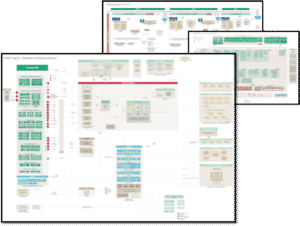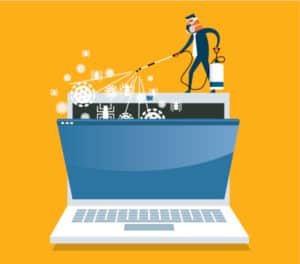Our work with multiple HCM systems implementation programs has revealed that integration and data architecture are critical to successful HCM transformation. They are also two of the most difficult elements. Gartner shared this opinion stating that ‘by 2022, 75% of all cloud-based human capital management software projects will fail to meet objectives due to an insufficient focus on addressing integration challenges.’ (HCM Integration Strategy: Key Planning Considerations, 2020) Embedding any modern system into a legacy environment comes with considerable integration demands, and human capital management proposes unique challenges.
In this article I’m going to share some of our most vital learnings from our recent client engagements around embedding a HCM system into a complex environment, with a deep dive into Workday integration.
Embedding HCM Systems into a Complex Environment
HR processes span across every department of an organisation. Couple this with a mish mash of legacy mainframe systems, cloud environments and SaaS solutions that are commonplace in large businesses, and it’s not hard to imagine that embedding a modern HCM system into an established environment presents a number of functional and technical challenges.
Functional Challenges
HR processes such as recruitment and onboarding are a critical part of attracting and retaining the best talent. They also touch multiple departments and often external agencies such as recruitment agencies, training, IT access, payroll and external auditing companies. This makes them both highly visible and complicated to manage. Another layer is that HR use cases cover people not just during their employment but before and after their tenure as well.
Another functional challenge is the complex payroll scenarios that are dependent on HR data. Employee lifecycle changes such as rehires, transfers and secondments and employee leave all need to be carefully managed to ensure payroll is accurate. There are various types of award entitlements, and they accrue at different rates, with unique business rules for every organisation e.g. access to long service leave may start at 10 years in one organisation, 15 at another. With HCM transformation it is anticipated that HCM systems will become the master of managing business processes and data that drive payroll processes – therefore HCM-to-payroll integrations are critical.
Understanding the intricacies of HR data and processes is a first critical step in planning for a successful HCM transformation. Refer to our example HCM process functional map to see an end-to-end view of the HR function in a large organisation via a technology, people, and process lens. This diagram demonstrates the breadth of processes a modern HCM system manages.
Technical Challenges
The technical challenges faced are primarily around data. An organisation’s existing HR data model often needs to be reworked for use in a modern HCM solution. This is because many businesses have been using payroll systems (such as Aurion or Chris21) and/or 15-20 year old legacy systems as their HR system, and moving to a modern HCM system like Workday changes the data scope completely. For example, the HCM data scope spans across new areas such as learning, performance management and talent and these require different representations of core HR datasets such as the way a system records a person and the multiple positions they hold through their tenure.
There is also a huge number of systems that consume HR data in large organisations. In our recent work on the HCM transformation program for a large Australian organisation the new HCM system will need to integrate with approximately 50 downstream systems.
Data Integration Approach for Workday
With the above in mind, let’s look at four key elements critical to a successful Workday implementation:
Integration Architecture and Platform
The end-to-end integration architecture and platform approach is the first key step here. End-to-end means within and outside of Workday. Workday provides very strong data integration capabilities (many patterns are supported).
For larger organisations with complex use cases and significant data transformation and / or orchestration, I recommend building standard interfaces in Workday and completing data transformation outside Workday. Though this is a larger upfront cost, it will inevitably save time and money in the long run. This is because external data transformation makes it much easier when changes are required to downstream systems, and it enables HR data to be more readily accessible to many different systems – both very common scenarios in large organisations. If an enterprise also has an existing integration platform investment, it can make this approach particularly attractive. This approach reduces reliance on specialist Workday skill sets to support the solution long term.
For smaller organisations, on the other hand, use cases are generally much more simple and there is limited need or the effort required versus the return for data transformation is not justified. In this scenario, I would recommend using the standard Workday integration capabilities to connect the organisation’s downstream systems. Workday provides many pre-built connectors with known SaaS platforms, making this a more time and cost effective approach for small businesses.
Plan for Detailed Data Mapping
In a typical large organisation most modern HCM systems will be connecting to a large number of downstream operational systems. This means data mapping from a new Workday data model to existing systems’ model is an essential part of the integration design phase. It is also very time consuming and complex, and in my experience projects rarely factor in enough time for this activity. Data mapping designs should take into account the realistic effort of integrating. The same rings true for education and familiarisation with HCM data; data models for SaaS HCM systems like Workday are not relational and hence can be difficult to understand – there is no data dictionary for Workday. The lack of similarity to legacy systems may mean more education is needed for BAU and integration delivery teams like those who will be using the data model to design and implement integration with the new HCM system.
Based on our experience we have developed some standard templates for Workday data objects such as Worker, Organisation, Positions, Learning and Payroll data mapping. These types of assets help to accelerate the integration design phase.
Architect and Implement Continuous Improvement
Modern HCM transformation using systems like Workday is not just a set-and-forget activity. This is no longer a question of another system implementation that will serve the business for another 20 years. Workday releases new features and functionality every 6 months and the Workday data integration approach must be able to accommodate new business needs on a continual basis. The integration approach must validate and consider using modern integration platforms that support patterns such as APIs, Data Hub, Data Virtualisation and ESB to support continuous improvement. Download an example solution roadmap that shows how the interaction of a HCM system might evolve over three phases within a business.
Choose the Right Integration Partner
Workday partner consultants have a deep understanding of the Workday platform, and are naturally the first choice when implementing Workday in isolation. But a holistic integration partner, with Workday integration experience, can offer huge value on larger complex projects. This is due to the combination of specialist knowledge around HR data dependencies along with the ability to tailor the integration approach based on an organisation’s system landscape, internal resources and business requirements.
Refer to an example HCMS integration architecture blueprint that demonstrates the complexity of data flows between Workday and business systems in an enterprise environment.There’s no one size fits all approach for Workday HCM Integration. We have helped many customers build end-to-end HCM integration solutions using integration technologies such as MuleSoft, AWS, Axway, Oracle ESB, Apache Nifi and UiPath RPA.
Whilst the above experience is primarily described based on Workday HCM implementations, the same principles and guidelines also apply for HCM integration using other vendors like SAP Successfactor, Oracle HCM Cloud and Netsuite. Appreciation of and planning for complexity are key to reaping the rewards of such transformations.
Get started on the planning and delivery of your own HCM Transformation project – download three sample HCM Transformation artefacts below:



